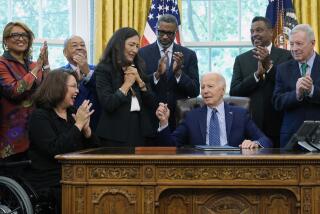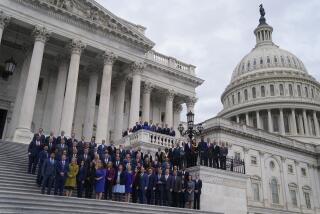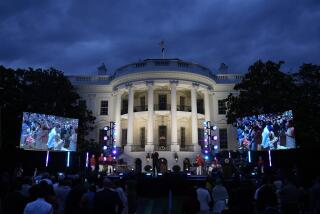Statue of Frederick Douglass dedicated at U.S. Capitol
WASHINGTON — Fourteen-year-old April Greene traveled from Murfreesboro, Tenn., with her family to watch Congress dedicate a statue of her ancestor — abolitionist leader Frederick Douglass, born a slave in 1818.
“I’m his great-great-great-granddaughter,” she said, counting the “greats” on her fingers. “It’s an honor.”
On Wednesday, other descendants and national and local officials gathered in the U.S. Capitol Visitor Center for the ceremony.
Douglass’ statue is the fourth honoring an African American in the Capitol, after statues of the Rev. Martin Luther King Jr., Rosa Parks and Sojourner Truth.
[Updated, 11:43 a.m. July 12: The statue, sculpted by Steven Weitzman, arrived in the visitor center’s Emancipation Hall, dedicated in 2007 to honor the slave laborers who built the Capitol, after a decade-long struggle between District of Columbia residents and Congress.]
Because only states may place statues in the Capitol, the question of moving the Douglass statue from a Washington office building became conflated with congressional Republican opposition to D.C. statehood. In 2012, the Senate approved a measure allowing the Douglass statue.
“It’s a feat of those who have labored long to bring him here,” said Washington resident Viviane Smith, former president of the Frederick Douglass Memorial and Historical Assn.
Speakers told of Douglass’ work as an abolitionist, advisor to President Lincoln and advocate for justice and equality.
“How easy it would have been for a man born in chains to have the opposite views,” said speaker Nettie Washington Douglass, a descendant of both Douglass and Booker T. Washington. “Though I cling tightly, he is not my own, he gave his spirit as a birthright to all of us.”
The 1,700-pound, 7-foot bronze Douglass grasps a paper in one hand, his other resting upon a lectern complete with quill and ink.
Douglass learned to read and write from his master’s wife and later by observing white children in his Baltimore neighborhood.
“He was going to get as much knowledge as he could to better his circumstances and of his race, but not only of his race, but of human beings themselves,” said April’s father, Patrick Greene.
Douglass escaped in 1838, starting the antislavery newspaper “The North Star” in Rochester, N.Y. After his house burned down, Douglass moved to Washington, where he served as a U.S. marshal and register of deeds.
“To me, he represents the American self-made person, taking what opportunity he could so he could work not only for D.C., but the nation as a whole,” said Carl Cole, a Washington art commissioner.
“As a freed man, he was a leader of the Republican Party, the party of freedom and progress,” Sen. Minority Leader Mitch McConnell (R-Ky.) said, noting that at the Republican National Convention 133 years to the date of the ceremony, Douglass became the first African American to receive a roll-call vote for president.
On the bottom of Douglass’ statue reads a quote from an 1857 speech he delivered in Canandaigua, N.Y.: “Without struggle, there is no progress.”
More to Read
Sign up for Essential California
The most important California stories and recommendations in your inbox every morning.
You may occasionally receive promotional content from the Los Angeles Times.









